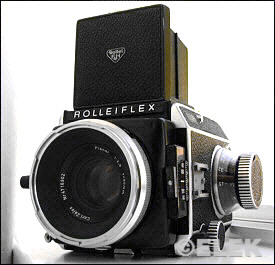Rolleiflex SL66

|
|
|
| Style, film format | Single-lens reflex system using 120 roll film |
|
|
|
| Lens, shutter | 80mm f/2.8 Carl Zeiss Planar |
|
|
|
| Photo quality | Excellent |
|
|
|
| Ergonomics | Because of the weight, best used on a tripod |
|
|
|
Hands down, this is the largest and heaviest camera that I own. It dwarfs everything else both in sheer physical dimensions, as well as weight.
In the real world, the Rolleiflex SL66 is meant for tripod use. Certainly, you can use it handheld, and I've done that a number of times. Hanging from your neck, it's big and somewhat ungainly as you try to muscle it into position. With the accessory handgrip, the camera is more manageable, but its weight works against it as a camera you can carry all day.
Sitting on a tripod, it becomes almost a different camera -- quick and much easier to use.
It's not a camera for discrete photography. The SL66's mirror slap and loud shutter announce its presence to everyone within earshot.
Despite its heft, this isn't a camera for heavy-handed users. It responds best to a quick, light touch. If you're used to using a Rolleiflex twin-lens reflex, then the SL66 will feel very natural. Like the Rolleiflex TLRs, the focusing knob is on the left, the film advance crank is on the right and the shutter release is (looking at the camera) on the lower left corner.
The lenses are excellent -- world-class pieces of glass. In addition to the standard 80mm f/2.8 Carl Zeiss Planar, I'm also lucky enough to own the 150mm f/4.0 Carl Zeiss Sonnar and the 50mm f/4.0 Carl Zeiss Distagon. Both are sturdy lenses that deliver excellent results.
The lens racks out via built-in bellows for 1:2 reproduction. You can reverse the lens for 2:1 macro purposes, and the lens standard offers vertical tilt for achieving excellent depth of field at wide apertures. I haven't yet had the opportunity to try this feature.
The camera uses a vertically traveling cloth focal-plane shutter with speeds running from 1 second to 1/1000, plus B. Flash synchronization is at 1/30, and this is what really hurt it with studio photographers. Rollei eventually offered lenses with leaf shutters, but they certainly weren't enough to compete with Hasselblad.
The film back can be a bit tricky, and if you force the film insert into the magazine, you'll certainly damage it. As I said, use a light touch and take your time. There is a mirror lockup, which will help with the slower speeds, and a depth-of-field preview lever.
There is so much to the camera that it's impossible to cover all of it. Suffice to say, this camera requires a strong back and a big wallet. It will deliver photos with excellent sharpness, contrast and color fidelity.
